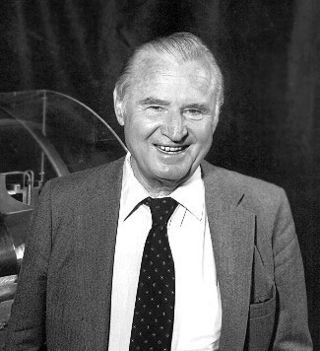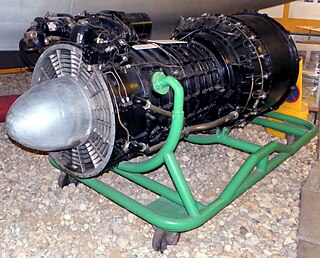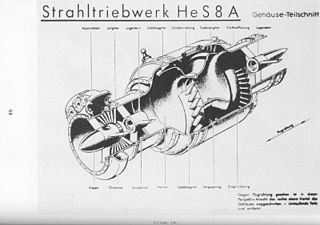
A jet engine is a type of reaction engine, discharging a fast-moving jet of heated gas that generates thrust by jet propulsion. While this broad definition may include rocket, water jet, and hybrid propulsion, the term jet engine typically refers to an internal combustion air-breathing jet engine such as a turbojet, turbofan, ramjet, pulse jet, or scramjet. In general, jet engines are internal combustion engines.

The turbojet is an airbreathing jet engine which is typically used in aircraft. It consists of a gas turbine with a propelling nozzle. The gas turbine has an air inlet which includes inlet guide vanes, a compressor, a combustion chamber, and a turbine. The compressed air from the compressor is heated by burning fuel in the combustion chamber and then allowed to expand through the turbine. The turbine exhaust is then expanded in the propelling nozzle where it is accelerated to high speed to provide thrust. Two engineers, Frank Whittle in the United Kingdom and Hans von Ohain in Germany, developed the concept independently into practical engines during the late 1930s.

Hans Joachim Pabst von Ohain was a German physicist, engineer, and the designer of the first turbojet engine to power an aircraft. Together with Frank Whittle he is widely described as the co-inventor of the turbojet engine. Hans von Ohain was still a university student when in January 1930, Whittle filed his first patent for a turbojet engine. Von Ohain stated in his biography, that "My interest in jet propulsion began in the fall of 1933 when I was in my seventh semester at Göttingen University. I didn't know that many people before me had the same thought.". He quickly caught up with Whittle due to the support by Heinkel and his design, "an axial-flow engine as opposed to Sir Frank's centrifugal flow engine, that was eventually adopted by most manufacturers by the 1950's."

The Heinkel He 178 was an experimental aircraft designed and produced by the German aircraft manufacturer Heinkel. It was the world's first aircraft to fly using the thrust from a turbojet engine.

The Junkers Jumo 004 was the world's first production turbojet engine in operational use, and the first successful axial compressor turbojet engine. Some 8,000 units were manufactured by Junkers in Germany late in World War II, powering the Messerschmitt Me 262 fighter and the Arado Ar 234 reconnaissance/bomber, along with prototypes, including the Horten Ho 229. Variants and copies of the engine were produced in Eastern Europe and the USSR for several years following the end of WWII.

The BMW 003 is an early axial turbojet engine produced by BMW AG in Germany during World War II. The 003 and the Junkers Jumo 004 were the only German turbojet engines to reach production during World War II.
This article outlines the important developments in the history of the development of the air-breathing (duct) jet engine. Although the most common type, the gas turbine powered jet engine, was certainly a 20th-century invention, many of the needed advances in theory and technology leading to this invention were made well before this time.

The Metropolitan-Vickers F.2 is an early turbojet engine and the first British design to be based on an axial-flow compressor. It was an extremely advanced design for the era, using a nine-stage axial compressor, annular combustor, and a two-stage turbine.

The Heinkel HeS 011 or Heinkel-Hirth 109-011(HeS - Heinkel Strahltriebwerke) was an advanced World War II jet engine built by Heinkel-Hirth. It featured a unique compressor arrangement, starting with a low-compression impeller in the intake, followed by a "diagonal" stage similar to a centrifugal compressor, and then a three-stage axial compressor. Many of the German jet-powered aircraft designs at the end of the war were designed to use the HeS 011, but the HeS 011 engine was not ready for production before the war ended in Europe and only small numbers of prototypes were produced.
A jet engine performs by converting fuel into thrust. How well it performs is an indication of what proportion of its fuel goes to waste. It transfers heat from burning fuel to air passing through the engine. In doing so it produces thrust work when propelling a vehicle but a lot of the fuel is wasted and only appears as heat. Propulsion engineers aim to minimize the degradation of fuel energy into unusable thermal energy. Increased emphasis on performance improvements for commercial airliners came in the 1970s from the rising cost of fuel.
The HeS 30(HeS - Heinkel Strahltriebwerke) was an early jet engine, originally designed by Adolf Müller at Junkers, but eventually built and tested at Heinkel. It was possibly the best of the "Class I" engines, a class that included the more famous BMW 003 and Junkers Jumo 004. As it started somewhat later than these two designs, and was thus expected to enter service later, the Reichluftfahrtministerium (RLM) ordered Heinkel to stop work on the design and put their efforts into more advanced designs.
Helmut Schelp was the director of advanced engine development at the RLM's T-Amt technical division leading up to and during World War II. He used his office to fund a widespread program in jet engine development, which led to many of the engine concepts still used today. In particular, he was instrumental in favoring the use of axial compressors over the simpler but "fatter" centrifugal compressors. Unlike in England where the jet had no single champion within the Air Ministry and their efforts were long delayed as a result, Schelp can be directly credited with the advancement and refinement of the jet in Germany over a few years.

The Heinkel HeS 8 was an early jet engine designed by Hans von Ohain while working at Heinkel. It was the first jet engine to be financially supported by the RLM, bearing the official name 109-001. Had development continued it would have been known as the Heinkel 001, but it does not appear this was used in practice.

The Motorlet M-701 is a Czechoslovak jet engine. It was used to power the Aero L-29 Delfín jet trainer, with about 9,250 engines built between 1961 and 1989.

The Power Jets W.1 was a British turbojet engine designed by Frank Whittle and Power Jets. The W.1 was built under contract by British Thomson-Houston (BTH) in the early 1940s. It is notable for being the first British jet engine to fly, as the "Whittle Supercharger Type W1", powering the Gloster E.28/39 on its maiden flight at RAF Cranwell on 15 May 1941. The W.1 was superseded by the Power Jets W.2.
The West Engineering XJ38 was a small turbojet engine created by modifying World War II-surplus aircraft engine turbosuperchargers. Intended to be a cheap method of producing jet engines for target drones for the United States Navy, the latter lost interest in the project, which was soon discontinued because of lack of funding.
The Packard XJ49 was the first U.S. designed turbofan aircraft engine, and was developed by the Packard Motor Co. in the 1940s.
The Packard XJ41 was a turbojet aircraft engine developed by the Packard company in the mid-1940s.
The Power Jets WU was a series of three very different experimental jet engines produced and tested by Frank Whittle and his small team in the late 1930s.











